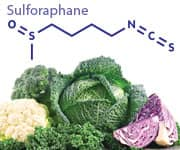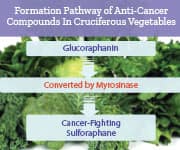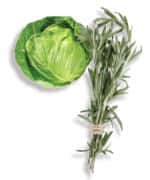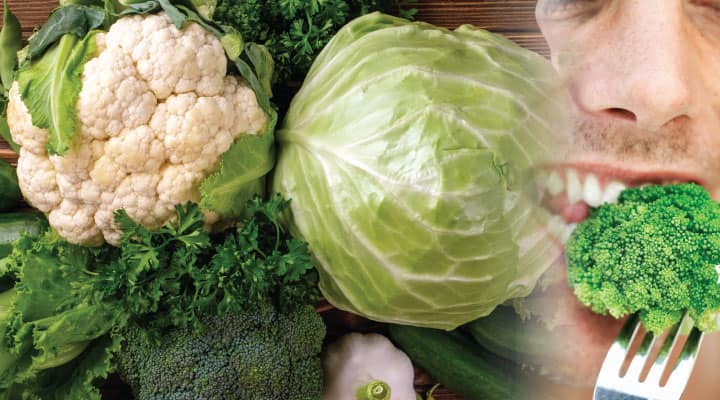Life Extension Magazine®
Roughly 1.8 million Americans are diagnosed with cancer each year.
More than 600,000 people in the United States die from it annually.1,2
It doesn’t have to be this way.
Many cancers are preventable.
Improving diet, increasing exercise, and changing unhealthy behaviors can significantly reduce risk.3
Studies show that higher intake of cruciferous vegetables is associated with a reduced risk for cancers.4,5
Ongoing research points to anti-cancer effects of compounds found in broccoli and other cruciferous vegetables.
One clinical trial showed that a specific cruciferous vegetable nutrient triggered a complete resolution of pre-cancerous cervical lesions in 100% of women, removing the risk that the lesions could develop into cancer.6
Until recently, it was difficult to deliver these cruciferous nutrients into the bloodstream at high enough levels to be effective.
Scientists have found a way to maximize the activity of cruciferous compounds so that they can reach tissues throughout the body.
Cruciferous Vegetable Compounds

Cruciferous vegetables are a group of edible plants that include broccoli, kale, green and red cabbage, cauliflower, and Brussels sprouts.
They are loaded with nutrients shown to help prevent a wide variety of common disorders.
In particular, cruciferous vegetables have demonstrated the ability to protect cells from several processes that result in malignant transformations.4,5
Two cruciferous nutrients are especially well validated for their cancer-fighting properties:
- Sulforaphane
- DIM (3, 3’-diindolylmethane).6-8
Findings from Johns Hopkins
In a seminal 1994 study from Johns Hopkins, rats were split into two groups. One was treated with sulforaphane, and one was not.9
All the animals were then exposed to a powerful cancer-inducing chemical.
The sulforaphane-treated rats developed 39% fewer tumors than the untreated group. And the tumors that did develop progressed at a slower rate.
Other studies have produced similar findings, showing that sulforaphane kills cancer stem cells, slows the growth of tumors, and promotes the death of cancer cells.10-12
In lab and animal studies, sulforaphane has been associated with diminished growth of cancer cells and a reduced risk of many types of cancer including:
- Breast,10-12
- Bladder,13
- Lung,14
- Prostate,15,16
- Cervix,17-19
- Blood (leukemia),20-22
- Mouth,23 and
- Brain.24,25
The other active compound in broccoli, DIM, also shows the ability to slow or even stop cancer cells from growing.
In one remarkable study, women with cervical intraepithelial neoplasia, a cervical cancer precursor, were treated with DIM.
After three to six months, 100% of women receiving 200 mg of DIM daily had their neoplasia completely resolved, compared to 61% of women in a placebo group.6
What’s most striking about these cruciferous compounds is that they have shown these effects on cancer in virtually every tissue studied.
How Plants Create Sulforaphane
You can’t get these benefits by simply popping a pill containing sulforaphane.
The reason is that while DIM is stable, sulforaphane is not. It degrades rapidly into inactive substances if it isn’t quickly absorbed.26
Nature has found a way around this problem.
Sulforaphane isn’t contained in cruciferous vegetables. Instead, cruciferous plants store a sulforaphane precursor called glucoraphanin in their cells.
In a separate cellular compartment, plants store an enzyme called myrosinase, that converts glucoraphanin into sulforaphane.
Only when the vegetables have been eaten and partially digested do the glucoraphanin and myrosinase mix, to form sulforaphane, the cancer-fighting compound.
Sulforaphane can then be absorbed through the small intestine before it degrades.
What you need to know
The Cancer-Fighting Power of Cruciferous Veggies
- Cruciferous vegetables include broccoli, cabbage, cauliflower, Brussels sprouts, and kale.
- Two cruciferous nutrients are especially well validated for their cancer-fighting properties: sulforaphane and 3,3’-diindolylmethane (DIM).
- Unlike DIM, sulforaphane is unstable. It degrades rapidly if it’s not absorbed.
- Scientists have found a way to package a sulforaphane precursor with an enzyme that converts it into sulforaphane in the small intestine, where it’s absorbed into the bloodstream right away.
- Together, sulforaphane and DIM can prevent changes that lead to cancer, stop tumors from developing and spreading, and even cause cancer cells to die off.
Science Imitates Nature

The trick for researchers was to find a similar way to deliver sulforaphane to the small intestine before it breaks down.
One group of scientists came up with an ingenious solution: imitate nature.
They developed a delivery system that keeps stable glucoraphanin and active myrosinase in separate compartments, just the way plants do.
Taken orally, these two components meet and mix only in the small intestine.
That means higher levels of cancer-fighting sulforaphane can be achieved.
The results are striking. Scientists at Johns Hopkins found that sulforaphane levels from this gluco-raphanin-myrosinase mix are three to four times more bioavailable (absorbable) than those created by glucoraphanin alone.27
How Sulforaphane and DIM Work
Sulforaphane and DIM have shown the ability to reduce cancer risk and malignant changes in four important ways:
- Stop deleterious epigenetic gene expression changes from occurring,
- Reduce or minimize cancer-promoting chronic inflammation,
- Fight estrogen-driven stimuli that encourage cancer cell replication and spread and
- Impede pre-cancerous cells from developing into tumors.
Stopping Epigenetic Changes
Cancer can be caused by epigenetic changes, the ability to “turn genes on and off.”
Epigenetic changes can be described as changing gene expression via one’s behavior or inadvertent exposure to outside toxins like air pollution.
By way of example, smoking cigarettes causes deleterious epigenetic changes that make the smoker more vulnerable to certain cancers.
Fish oil and vitamin D, on the other hand, have been shown to induce beneficial epigenetic changes.
These changes don’t alter the DNA, but they change expression patterns of genes.
Research has shown that sulforaphane and DIM can reverse some of these cancer-associated changes.16
One example of this is that sulforaphane reverses alterations in histone proteins involved in the regulation of genes, an epigenetic change that can help prevent cancer formation.28,29 This mechanism is so important, it’s a target of many new cancer drugs under development.30-32
Suppressing Inflammation
Chronic inflammation contributes to practically every age-related disease—including cancer.
Our bodies have a “master switch” that regulates the signaling molecules that drive inflammation. It’s called nuclear factor-kappa B (NF-kB).
Studies show that sulforaphane blocks NF-kB, reducing inflammation throughout the body. Along the way, sulforaphane kills cancer stem cells that can trigger tumor recurrence.11,33
Fighting Estrogen-Driven Stimuli
Certain estrogens stimulate proliferation of some existing breast and prostate cancers.34-36
Sulforaphane combats the potential DNA-damaging effects of estrogen, preventing the early DNA damage that leads to cancers.37-39
DIM helps shift the balance between two different forms of estrogen metabolites, away from one that promotes cancer and toward one that inhibits it.40
In women who have had breast cancer, human studies show that daily DIM shifts estrogen metabolites toward a preponderance of the healthier form.40,41
In men, higher estrogen levels are associated with prostate enlargement and cancers. Studies show DIM can prevent estrogen-induced stimulation of prostate cancer cells.42,43
Stop Developing Tumors in their Tracks
Sulforaphane has demonstrated the ability to suppress signals and enzymes that spur growth of tumors, and to reduce formation of blood vessels that feed them.44-49
DIM has also been shown to reduce new blood vessel formation in tumors and to inhibit the spread of cancer.50
And both compounds spur cancer cells to die off, while leaving normal, healthy cells unharmed.51,52
These actions prevent pre-cancerous cells from developing into cancer and slow the growth of existing cancer.
Summary

Cruciferous vegetables like broccoli have proven capable of slowing and even reversing the development of many types of cancer.
Research shows that many of the anti-cancer effects are due to two compounds derived from these vegetables: sulforaphane and DIM.
While DIM is stable and easily absorbed when taken orally, sulforaphane is rapidly converted to inactive compounds.
To solve this problem, scientists developed a delivery system (glucoraphanin plus myrosinase) that maximizes the amount of sulforaphane available for absorption into the bloodstream.
By separating these precursor plant compounds, much more sulforaphane becomes bioavailable in the small intestine. There, it can be rapidly absorbed, delivering higher blood levels of this beneficial (sulforaphane) compound.
If you have any questions on the scientific content of this article, please call a Life Extension® Wellness Specialist at 1-866-864-3027.
References
- Available at: https://www.cancer.gov/about-cancer/understanding/statistics. Accessed 17 January, 2020.
- Available at: https://seer.cancer.gov/statfacts/html/common.html. Accessed May 22, 2020.
- Anand P, Kunnumakkara AB, Sundaram C, et al. Cancer is a preventable disease that requires major lifestyle changes. Pharm Res. 2008 Sep;25(9):2097-116.
- Dinkova-Kostova AT, Fahey JW, Kostov RV, et al. KEAP1 and Done? Targeting the NRF2 Pathway with Sulforaphane. Trends Food Sci Technol. 2017 Nov;69(Pt B):257-69.
- Verhoeven DT, Goldbohm RA, van Poppel G, et al. Epidemiological studies on brassica vegetables and cancer risk. Cancer Epidemiol Biomarkers Prev. 1996 Sep;5(9):733-48.
- Ashrafian L, Sukhikh G, Kiselev V, et al. Double-blind randomized placebo-controlled multicenter clinical trial (phase IIa) on diindolylmethane’s efficacy and safety in the treatment of CIN: implications for cervical cancer prevention. EPMA J. 2015;6:25.
- Kyung SY, Kim DY, Yoon JY, et al. Sulforaphane attenuates pulmonary fibrosis by inhibiting the epithelial-mesenchymal transition. BMC Pharmacol Toxicol. 2018 Apr 2;19(1):13.
- Su X, Jiang X, Meng L, et al. Anticancer Activity of Sulforaphane: The Epigenetic Mechanisms and the Nrf2 Signaling Pathway. Oxid Med Cell Longev. 2018;2018:5438179.
- Zhang Y, Kensler TW, Cho CG, et al. Anticarcinogenic activities of sulforaphane and structurally related synthetic norbornyl isothiocyanates. Proc Natl Acad Sci U S A. 1994 Apr 12;91(8):3147-50.
- Bose C, Awasthi S, Sharma R, et al. Sulforaphane potentiates anticancer effects of doxorubicin and attenuates its cardiotoxicity in a breast cancer model. PLoS One. 2018;13(3):e0193918.
- Burnett JP, Lim G, Li Y, et al. Sulforaphane enhances the anticancer activity of taxanes against triple negative breast cancer by killing cancer stem cells. Cancer Lett. 2017 May 28;394:52-64.
- Yang F, Wang F, Liu Y, et al. Sulforaphane induces autophagy by inhibition of HDAC6-mediated PTEN activation in triple negative breast cancer cells. Life Sci. 2018 Nov 15;213:149-57.
- Abbaoui B, Telu KH, Lucas CR, et al. The impact of cruciferous vegetable isothiocyanates on histone acetylation and histone phosphorylation in bladder cancer. J Proteomics. 2017 Mar 6;156:94-103.
- Wang DX, Zou YJ, Zhuang XB, et al. Sulforaphane suppresses EMT and metastasis in human lung cancer through miR-616-5p-mediated GSK3beta/beta-catenin signaling pathways. Acta Pharmacol Sin. 2017 Feb;38(2):241-51.
- Alumkal JJ, Slottke R, Schwartzman J, et al. A phase II study of sulforaphane-rich broccoli sprout extracts in men with recurrent prostate cancer. Invest New Drugs. 2015 Apr;33(2):480-9.
- Wong CP, Hsu A, Buchanan A, et al. Effects of sulforaphane and 3,3’-diindolylmethane on genome-wide promoter methylation in normal prostate epithelial cells and prostate cancer cells. PLoS One. 2014;9(1):e86787.
- Ali Khan M, Kedhari Sundaram M, Hamza A, et al. Sulforaphane Reverses the Expression of Various Tumor Suppressor Genes by Targeting DNMT3B and HDAC1 in Human Cervical Cancer Cells. Evid Based Complement Alternat Med. 2015;2015:412149.
- Cheng YM, Tsai CC, Hsu YC. Sulforaphane, a Dietary Isothiocyanate, Induces G(2)/M Arrest in Cervical Cancer Cells through CyclinB1 Downregulation and GADD45beta/CDC2 Association. Int J Mol Sci. 2016 Sep 12;17(9).
- Sharma C, Sadrieh L, Priyani A, et al. Anti-carcinogenic effects of sulforaphane in association with its apoptosis-inducing and anti-inflammatory properties in human cervical cancer cells. Cancer Epidemiol. 2011 Jun;35(3):272-8.
- Fimognari C, Turrini E, Sestili P, et al. Antileukemic activity of sulforaphane in primary blasts from patients affected by myelo- and lympho-proliferative disorders and in hypoxic conditions. PLoS One. 2014;9(7):e101991.
- Koolivand M, Ansari M, Piroozian F, et al. Alleviating the progression of acute myeloid leukemia (AML) by sulforaphane through controlling miR-155 levels. Mol Biol Rep. 2018 Dec;45(6):2491-9.
- Shang HS, Shih YL, Lee CH, et al. Sulforaphane-induced apoptosis in human leukemia HL-60 cells through extrinsic and intrinsic signal pathways and altering associated genes expression assayed by cDNA microarray. Environ Toxicol. 2017 Jan;32(1):311-28.
- Bauman JE, Zang Y, Sen M, et al. Prevention of Carcinogen-Induced Oral Cancer by Sulforaphane. Cancer Prev Res (Phila). 2016 Jul;9(7):547-57.
- Kumar R, de Mooij T, Peterson TE, et al. Modulating glioma-mediated myeloid-derived suppressor cell development with sulforaphane. PLoS One. 2017;12(6):e0179012.
- Miao Z, Yu F, Ren Y, et al. d,l-Sulforaphane Induces ROS-Dependent Apoptosis in Human Gliomablastoma Cells by Inactivating STAT3 Signaling Pathway. Int J Mol Sci. 2017 Jan 4;18(1).
- McNaughton SA, Marks GC. Development of a food composition database for the estimation of dietary intakes of glucosinolates, the biologically active constituents of cruciferous vegetables. Br J Nutr. 2003 Sep;90(3):687-97.
- Fahey JW, Holtzclaw WD, Wehage SL, et al. Sulforaphane Bioavailability from Glucoraphanin-Rich Broccoli: Control by Active Endogenous Myrosinase. PLoS One. 2015;10(11):e0140963.
- Bayat Mokhtari R, Baluch N, Homayouni TS, et al. The role of Sulforaphane in cancer chemoprevention and health benefits: a mini-review. J Cell Commun Signal. 2018 Mar;12(1):91-101.
- Tortorella SM, Royce SG, Licciardi PV, et al. Dietary Sulforaphane in Cancer Chemoprevention: The Role of Epigenetic Regulation and HDAC Inhibition. Antioxid Redox Signal. 2015 Jun 1;22(16): 1382-424.
- Bai Y, Ahmad D, Wang T, et al. Research Advances in the Use of Histone Deacetylase Inhibitors for Epigenetic Targeting of Cancer. Curr Top Med Chem. 2019;19(12):995-1004.
- Damaskos C, Tomos I, Garmpis N, et al. Histone Deacetylase Inhibitors as a Novel Targeted Therapy Against Non-small Cell Lung Cancer: Where Are We Now and What Should We Expect? Anticancer Res. 2018 Jan;38(1):37-43.
- Srinivas NR. Clinical pharmacokinetics of panobinostat, a novel histone deacetylase (HDAC) inhibitor: review and perspectives. Xenobiotica. 2017 Apr;47(4):354-68.
- Ren K, Li Z, Li Y, et al. Sulforaphene enhances radiosensitivity of hepatocellular carcinoma through suppression of the NF-kappaB pathway. J Biochem Mol Toxicol. 2017 Aug;31(8).
- Yager JD, Davidson NE. Estrogen carcinogenesis in breast cancer. N Engl J Med. 2006 Jan 19;354(3):270-82.
- Santen RJ, Yue W, Wang JP. Estrogen metabolites and breast cancer. Steroids. 2015 Jul;99(Pt A):61-6.
- Briganti A. Oestrogens and prostate cancer: novel concepts about an old issue. Eur Urol. 2009 Mar;55(3):543-5.
- Wu Q, Odwin-Dacosta S, Cao S, et al. Estrogen down regulates COMT transcription via promoter DNA methylation in human breast cancer cells. Toxicol Appl Pharmacol. 2019 Mar 15;367:12-22.
- Yager JD. Mechanisms of estrogen carcinogenesis: The role of E2/E1-quinone metabolites suggests new approaches to preventive intervention--A review. Steroids. 2015 Jul;99(Pt A):56-60.
- Yang L, Zahid M, Liao Y, et al. Reduced formation of depurinating estrogen-DNA adducts by sulforaphane or KEAP1 disruption in human mammary epithelial MCF-10A cells. Carcinogenesis. 2013 Nov;34(11):2587-92.
- Thomson CA, Chow HHS, Wertheim BC, et al. A randomized, placebo-controlled trial of diindolylmethane for breast cancer biomarker modulation in patients taking tamoxifen. Breast Cancer Res Treat. 2017 Aug;165(1):97-107.
- Dalessandri KM, Firestone GL, Fitch MD, et al. Pilot study: effect of 3,3’-diindolylmethane supplements on urinary hormone metabolites in postmenopausal women with a history of early-stage breast cancer. Nutr Cancer. 2004;50(2):161-7.
- Smith S, Sepkovic D, Bradlow HL, et al. 3,3’-Diindolylmethane and genistein decrease the adverse effects of estrogen in LNCaP and PC-3 prostate cancer cells. J Nutr. 2008 Dec;138(12):2379-85.
- Chen D, Banerjee S, Cui QC, et al. Activation of AMP-activated protein kinase by 3,3’-Diindolylmethane (DIM) is associated with human prostate cancer cell death in vitro and in vivo. PLoS One. 2012;7(10):e47186.
- Annabi B, Rojas-Sutterlin S, Laroche M, et al. The diet-derived sulforaphane inhibits matrix metalloproteinase-9-activated human brain microvascular endothelial cell migration and tubulogenesis. Mol Nutr Food Res. 2008 Jun;52(6):692-700.
- Hunakova L, Sedlakova O, Cholujova D, et al. Modulation of markers associated with aggressive phenotype in MDA-MB-231 breast carcinoma cells by sulforaphane. Neoplasma. 2009;56(6):548-56.
- Pawlik A, Wiczk A, Kaczynska A, et al. Sulforaphane inhibits growth of phenotypically different breast cancer cells. Eur J Nutr. 2013 Dec;52(8):1949-58.
- Davis R, Singh KP, Kurzrock R, et al. Sulforaphane inhibits angiogenesis through activation of FOXO transcription factors. Oncol Rep. 2009 Dec;22(6):1473-8.
- Liu P, Atkinson SJ, Akbareian SE, et al. Sulforaphane exerts anti-angiogenesis effects against hepatocellular carcinoma through inhibition of STAT3/HIF-1alpha/VEGF signalling. Sci Rep. 2017 Oct 4;7(1):12651.
- Wang Y, Zhou Z, Wang W, et al. Differential effects of sulforaphane in regulation of angiogenesis in a co-culture model of endothelial cells and pericytes. Oncol Rep. 2017 May;37(5):2905-12.
- Chinnakannu K, Chen D, Li Y, et al. Cell cycle-dependent effects of 3,3’-diindolylmethane on proliferation and apoptosis of prostate cancer cells. J Cell Physiol. 2009 Apr;219(1):94-9.
- Pledgie-Tracy A, Sobolewski MD, Davidson NE. Sulforaphane induces cell type-specific apoptosis in human breast cancer cell lines. Mol Cancer Ther. 2007 Mar;6(3):1013-21.
- Kim SM. Cellular and Molecular Mechanisms of 3,3’-Diindolylmethane in Gastrointestinal Cancer. Int J Mol Sci. 2016 Jul 19;17(7).

